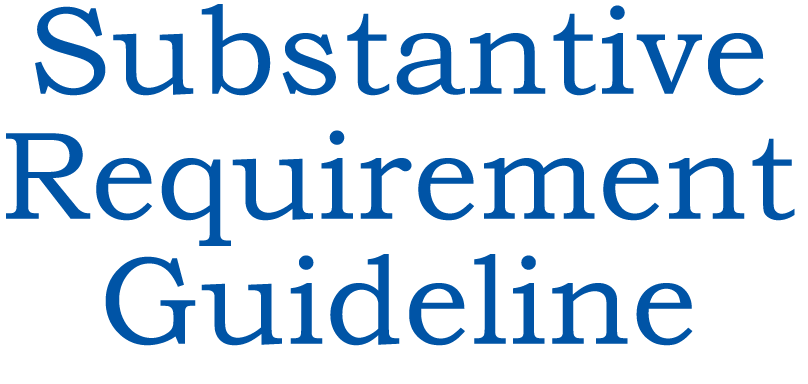What is included in the IEP document?
Page 9: Monitoring & Reporting Student Progress

Document how, and how frequently, a student’s progress toward his or her IEP goals will be measured and reported.
As we discussed on previous pages, a student’s PLAAFP statements inform her annual goals, which inform decisions about the special education and related services she will receive. Once these services and supports are identified, the IEP team needs to decide how they will determine whether the student’s program is effective (i.e., helping the student make appropriate progress). IDEA requires that every IEP contain a component in which IEP teams document:
- How a student’s progress toward meeting each annual goal will be measured
- When periodic reports on that progress will be provided to parents
Developing a Progress Monitoring Plan
To monitor student progress, IEP teams must make decisions about the nature of the data that will be collected and analyzed relevant to each annual goal. The most appropriate progress monitoring systems are those in which objective numerical data are collected frequently, graphed, analyzed, and then used to make instructional decisions. Anecdotal data and other subjective procedures are not appropriate for monitoring student progress and should not be the basis of a progress monitoring system.
To determine how a student’s progress toward meeting his or her annual goals will be measured, the team members can consider the guiding questions in the table below. The team’s collective responses to these questions should align with each annual goal and therefore be specific, measurable, realistic, and relevant to the timeframe.
|
Guiding Questions |
Tips |
|
How will the student’s progress be objectively measured? |
Do: Use objective measures (e.g., data that can be reported in numbers rather than words). Examples:
Don’t: Use subjective measures. Examples:
|
|
How often will the student’s progress be measured? |
Do: Measure frequently and systematically. Examples:
Don’t: Measure so inconsistently or infrequently that data-based changes to services and supports can’t occur. Examples:
|
|
Who is responsible for collecting progress monitoring data? |
Do: Identify an individual with appropriate data-collection training. Examples:
Don’t: Assume that an individual has the requisite skills to collect data. |
|
Where will data collection occur? |
Do: Clearly identify each relevant setting or context in which data will be collected. Examples:
Don’t: Broadly describe the setting or context (e.g., in the general education setting) or omit it completely. |
|
When will data collection occur? |
Do: Maintain a consistent data-collection schedule. Examples:
Don’t: Collect data on an inconsistent basis. Examples:
|
|
How well will the student need to perform in order to achieve his or her stated IEP goals (i.e., performance criteria)? |
Do: Use the performance criterion from the annual goal. Examples:
Don’t: Use different performance criterion than those stated in the annual goals. |
A good practice for assessing student progress is to use data from formative assessments to measure progress on the academic skill or functional behavior specified in the annual goal. These data can also be used to inform instructional decision making. Regularly and systematically collecting and monitoring student data allows the IEP team to evaluate the appropriateness of the student’s IEP. It also gives the team time, when the student is not making progress, to make adjustments to the student’s educational program so that she might still achieve the annual goals. These adjustments might include using different instructional methods, providing different services and supports, or reconsidering the student’s LRE.
formative assessment
glossary
The plan for monitoring and reporting student progress need not be cumbersome or overly time-consuming. In fact, plans that are too unwieldy or burdensome are less likely to be implemented with fidelity, if at all. IEP teams should consider monitoring and reporting methods that are user-friendly and time-efficient.
In this interview, Tamara McLean explains how different types of assessments help to inform both general education and special education teachers on a student’s progress (time: 2:54).

Tamara McLean
Exceptional Education Teacher
Transcript: Tamara McLean
Every school is different and every district is different. In our school, we do progress monitoring, and that progress monitoring happens weekly. Now not every goal may be monitored every week but it needs to be regular. To make our instruction valid we need to know exactly where they are. Because if we’re redoing skills that they really already have a reasonable grasp of, and we’re not checking in on that regularly, we are not moving on. We do hear about all the testing that is done and how much time is spent testing. And I do understand, especially from a gen ed teacher perspective, how much time that does take. But I also think special education is a different ballgame because we tailor our instruction specifically to each child. And gen ed teachers very much try to do that but, their entire training is moving a group on whereas in special education we are moving each child on from where they are. And so our views of testing I think are completely different. Our time needs to be spent only doing skills they need, only doing skills that apply big picture, and only will move them forward to the ultimate goal of whatever that subject is.
So when I started teaching, we didn’t really use the data like we do now. And we didn’t constantly recheck in: Where are our students? Are they making progress? Where is the gap? What do they need to get there? And I think as we are getting better about using this testing and being intentional about what we do with it, it really does focus your time which is important because we can waste a lot of time if we don’t know where kids are. I think though that sometimes you need to take pieces into the testing, when you look at the results. So when we look at things like TN Ready, which is Tennessee state testing, it’s timed. So it isn’t always a great example of specific skills and whether they have them or not. It’s just whether they can do them in the set amount of time. And then you have tests that we use in this district like the MAP test where it’s untimed. So using those two pieces of information together give us great information. Hey, they have the skill. They were able to do it over and over on the MAP test but they’re not able to access it quickly because they weren’t able to show us that on the TN Ready. So even those two tests, which we complain they say the same thing, they don’t. They tell us different things. When we put them together it gives us a bigger picture of what exactly we’re working on.
Legislation and Litigation 
The use of “teacher observation” by itself is not a legitimate way of monitoring student progress. As the New York State Educational Agency noted in a 2003 hearing…
although subjective teacher observation provides valuable information, teacher observation is not an adequate method of monitoring student progress
and
Without supporting data, teacher observation is opinion which cannot be verified
The progress monitoring plan should be clear and easy to understand. The data collected should be used to adjust the IEP document as needed. As the hearing officer in Escambia County Public School System (2004) concluded:
The most glaring deficiency was the absence of a notation as to whether [the student] had mastered any of his benchmarks . . . without the dates of mastery of benchmarks indicated on the IEP a parent cannot determine the progress that the child has been making during the school year… it is crucial that a parent (or other IEP member) be able to examine the IEP document to see if satisfactory progress is being made toward the attainment of the student’s annual goals and if not, whether there is a need for adjustments to his program (42 IDELR 248).
Reporting Progress to Parents
The IEP team must stipulate when periodic reports on the student’s progress will be provided to her parents. These reports keep the parents informed regarding whether their child is on track to achieve her annual goals. In cases in which the student is not on track to meet her goals, the report should describe the adjustments that school personnel intend to implement to help her do so. Depending on the nature of these adjustments, it might be necessary to schedule an IEP meeting to review the student’s individualized education program.
A good rule of thumb is to provide progress reports on the student’s annual goals at least as frequently as parents of students without disabilities receive progress reports (e.g., report cards). This is in addition to the daily or weekly progress reports that many teachers send home. For example, the parents of a 2nd-grade student who only receives special education services for reading might receive:
- The same weekly academic and behavior updates as the other parents
- A report card every nine weeks with grades for all of their child’s subjects
- A report on her progress toward meeting her annual IEP goals in reading
IEP teams should facilitate the parents’ understanding of the data so that they can clearly determine whether their child is making progress toward all of her annual goals. There are several considerations to keep in mind when reporting progress to parents:
- Avoid using jargon
- Use graphs to provide visual representations of the data
- Present information in parent’s home language whenever possible
- State clearly whether the student is on track to meet her annual goals
In this interview, Tamara McLean explains two different ways that teachers at her school report progress to parents (time: 1:19).
Tamara McLean
Exceptional Education Teacher

Transcript: Tamara McLean
In our school, some of the ways that we like to report information and the ways we are required to report information are not exactly the same. IEPs have a progress report piece, which really and truly is just telling us how they’re making progress on the goals. And every time a report card is sent home we send home the progress report on the IEP goals to the parents at the same time. So they can see how close they’re getting to mastery on that goal. We don’t get a lot of feedback from parents on it. So I’m not really sure how meaningful it is.
We send home data on our progress monitoring. We chart them in an excel spreadsheet. And every Wednesday when we do our progress monitoring, we, right there on the computer with the child, plug it into the computer and it generates on the graph to show where they have gone on that skill and backtracks all the way to when we started that particular skill. And sometimes the children will ask if they can print it off and take it home, because as much as the parent needs to see it, so does the child, they’re the one who is working on it. And so those graphs are a great way for them to actually see the growth versus the progress report we send home where we’re just putting a percentage towards mastery on there.
Implications of Endrew on Progress Monitoring and Reporting
Legislation and Litigation 
A substantive standard not focused on student progress would do little to remedy the pervasive and tragic academic stagnation that prompted Congress to act.
For Your Information
There is probably less substantive compliance with this component of the IEP than any other. Too often teachers don’t understand how to effectively collect and interpret data.
Recall that the Endrew ruling concerned itself, in part, with the quality of the education, as laid out in their IEPs, to which students with disabilities are entitled. The Supreme Court’s ruling requires that a higher substantive standard must now be used to determine educational benefit: An IEP must be “reasonably calculated to enable a child to make progress appropriate in light of the child’s circumstances.” To determine whether the student is making progress, IEP teams must create and implement a high-quality plan that allows them to systematically and consistently monitor and report the student’s progress toward meeting her annual goals. This plan must include a process for collecting objective data that can document improved academic and/or functional performance. As mentioned above, if the data indicate that a student is not on track to meet her annual goals, the IEP team should make adjustments to the education program and continue to monitor accordingly. Failure to make such adjustments, when data indicate the need, could result in a ruling that a school had denied FAPE to a student.
In the interview below, Mitchell Yell discusses monitoring and reporting considerations for students with disabilities (time: 0:59).

Mitchell Yell, PhD
Fred and Francis Lester Palmetto Chair in Teacher Education
Professor, Special Education
University of South Carolina
Transcript: Mitchell Yell, PhD
I would say probably the most efficient way of collecting data on basic skills is to use curriculum-based measurement. They’re easy to use, they’re very time-efficient, and they’re very reliable and valid data. Teachers need something that’s easy and doesn’t take a lot of time. So I would say curriculum-based measurement is an extremely good way to write goals and collect data on academic issues having to do with basic skills deficits.
To communicate with parents, I would say best-practice is not only collecting data, but graphing it. You know, a graph is almost intuitively understandable. You can look at a graph even if you don’t know what it means, and you can see if the child is making growth or not by looking at the graph. And that’s a very effective way to communicate with parents.